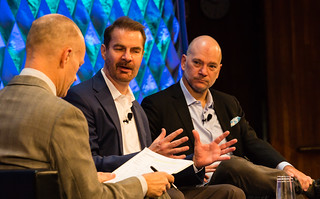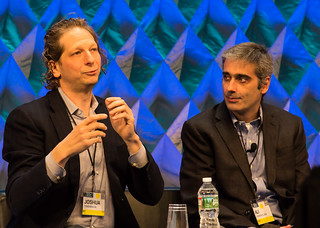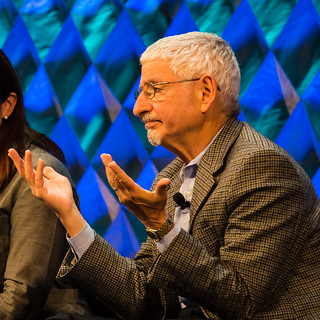For many people, Eclipse may not be the first open source organization that pops to mind when thinking about Internet-of-Things (IoT) projects. But, in fact, Eclipse hosts 28 projects that touch on a wide range of needs for organizations doing IoT projects. In September, I was attending the Eclipse IoT day and RedMonk's ThingMonk conference in London and had a chance to sit down with Ian Skerrett. Ian heads marketing for Eclipse and we spoke about Eclipse's IoT projects and how Eclipse thinks about IoT more broadly.
(Apologies for the audio quality not being quite up to my usual standards. We had to record this outside, it was a windy day, and I didn’t have any recording gear to mitigate the wind noise.)
Listen to podcast:
Links:
Transcript:
Gordon Haff: Hi everyone. This is Gordon Haff, Technology Evangelist with Red Hat. You're in the Cloudy Chat podcast. I'm at London at ThingMonk, RedMonk's annual event on IoT. I'm here at Shoreditch Studios, and I'm pleased to be here with Ian Skerrett who runs marketing for the Eclipse Foundation. Welcome Ian.
Ian Skerrett: Great to be here, Gordon. Thanks for having me.
Gordon: Ian, could you start off by giving a little bit of background for yourself, how you came to be at Eclipse, and what your role is at Eclipse?
Ian: As you said, I'm working at the Eclipse Foundation, and my official title is the Vice President of Marketing. I help bring together the community and talk about what the community is doing around the different open source projects. Lots of people don't know, but Eclipse is a huge community of well over 300 projects.
My specific role is on marketing, but I also deal a lot with IoT or IoT community which we're going to talk a bit more about. I probably spend half of my time on IoT right now.
Gordon: Eclipse has come a long way. I'm sure everybody listening to this has heard of Eclipse, but they probably think in terms of the IDE or some other specific development things. As you say, you have a very large presence in IoT today.
Before we get into the details of, specifically, what Eclipse is doing in IoT, you gave a talk yesterday where you discussed things like Industry 4.0. That might be a useful context in order to talk about what Eclipse is doing, specifically, in IoT.
Ian: Industry 4.0 is a term that probably started in Germany. It's reflective of how things get made, if you think about a factory floor. Lots of people know about the Industrial Revolution. The first Industrial Revolution, that was the start of steam power, steam powered machines.
The second Industrial Revolution was mass production. You think about car manufacturing, mass production around that.
The third Industrial Revolution is credited with automation and robotics that have gone into the factory plants. Where Industry 4.0 comes from is what people talk about, the fourth Industrial Revolution, is how do you start connecting all those factory floors, the machinery and automation machinery on the factory floors to the enterprise IoT system.
It's a term that comes out of Germany. Germany is the hub of industrial automation. That's where the machines that can make other machines that go into factory floors start off often. It started there. It's become an industry term that's been adopted globally and to talk about how do you start connecting up what a lot of people call the operational technology. The technology that's on the factory floor, to the enterprise IoT technology.
That's the context and one industry that IoT plays into. IoT is a general term that plays in pretty well every industry out there, be it automotive, be it wearables, be it healthcare, be it industrial automation and manufacturing.
Gordon: Before we go further, you touched on something, which our listeners will be interested in. One of the questions I hear a lot is we've been connecting things up in factories forever. We've had various types of industrial control systems. Many of these systems have been connected within modern factories. From your personal perspective, from Eclipse's perspective, how is IoT different besides being a cool new term?
Ian: You're right. A lot of factories are connected. A lot aren't though. There's a term called SCADA, Supervisory Control and Data Analysis. SCADA system would often be how you use IoT technology to monitor a factory. Often, SCADA systems and even the factory floor technology, is very proprietary, very siloed. It's hard to change it. It's hard to adapt to it.
One of the drivers of Industry 4.0 is that the manufacturing process is trying to be more flexible. Right now, when you set up a manufacturing run, you need to manufacture hundreds of thousands of that piece, of that unit. What they want to do is to meet customer demand, to have manufacturing processes that are very flexible, that you can actually do a lot size one.
You do an entire manufacturing process of just one unit and then change it as quickly as possible. To do that, it has to be much more flexible. Software has to be much more flexible. It has to be distributed, where the actual machines have the intelligence of what to do. That's a very new way of doing the software that's being put out on the factory floor. That's where the industry is going.
Gordon: It's a little bit like cloud has “been there since time‑sharing,” but obviously, it's qualitatively different today.
Ian: IoT and terms like embedded system development, a lot of this is being done. It's taking it to the next step where you can actually interoperate, where that information can run, having multiple factories talking to each other, doing data analysis across multiple factories, and just having a lot more flexibility that go to those systems.
Gordon: Let's talk about Eclipse. As we said in the beginning, there's activity across the whole IoT spectrum. A lot of people's attention is focused on more consumer‑type stuff, SmartHome, Roombas, what have you. Obviously, there's factories, there's transportation, logistics work. Out of all that, how is Eclipse thinking about where you want to put wood in your arrow, where you want focus?
Ian: Our goal is to be, when developers are building IoT solutions, they have set building blocks that they can draw on. An analogy I like to make is that, in early days of the web, I used to look at IBM. IBM used to have four different HTTP servers that they're trying to commercialize. They wanted to do e‑business, they wanted to have e‑commerce, and you need a web server to do that.
If you wanted a website, you needed a web server. They were trying to commercialize that. It turned out having HTTP server to sell had no value to any customer so they shut them all down, which are Apache.
What we can see in IoT is that there's core fundamental technology that every IoT solution needs, that want an open source. Everyone can use it so they can get broader adoption of it. The way we think first is that an IoT solution, there's three stacks of software.
What we see is that you need three different software stacks, building block technology for IoT. You need a stack of software for constrained devices, the MCU [microcontroller unit] level sensor type of hardware.
There's usually some type of a gateway that aggregates information and data from the different sensors and sends it to the network. You need a software stack for there.
And then a software stack for the IoT platform on the backend, on the cloud. Our goal is to be the provider of the underlying technology for those three stacks of software.
Gordon: One of the things about IoT that seems to be a good fit with open source is this idea of modularity and gluing things together. Without going into details here, we've seen a number of things over the past year [suggesting that] a monolithic software stack that handles everything isn't the best answer.
Ian: IoT is so broad. When you go to getting a solution done, there's very specific things that need to be built, but there's a lot of underlying technology that can be used like messaging protocol, like gateway services. It needs to be a modular approach to scale up to the different use cases that are up there.
It isn't just one big stack of software behind this. Certainly, the microservices were obviously constrained. The IoT needs to be working and moving in that direction too.
Gordon: Now, I know you love all your children and we don't want this to be a two‑hour podcast. We're going to bore our listeners, but what are some highlights of some of the projects on your Eclipse?
Ian: They're all amazing.
[laughter]
Ian: No, I'm just kidding. In reality, there's a maturity of IoT business projects. Let's start with what I would consider our more mature projects that are being used in production today. Certainly around MQTT, the messaging protocol for IoT. We have two projects, Eclipse Mosquitto and Eclipse Paho. Mosquitto is the broker, Paho is the client for MQTT. Those are widely used, widely successful.
If you're doing MQQT, you probably want to look at Paho and Mosquitto. MQTT has been a great success in terms of being a standard that's being widely adopted in IoT and an open source application.
Gordon: For our listeners, what is MQTT?
Ian: It's a pub/sub, publish‑subscribe messaging protocol that was designed specifically for oil and gas pipeline monitoring where power management network latency is really important. You can't have an HTTP client that's always pinging home. It's got to be a pub/sub.
Another project that's very mature and well‑used is Eclipse Kura, which is an IoT gateway. Essentially, it provides northbound and southbound connectivity. There's a lot of different protocols. There are Bluetooth, Modbus, CAN bus, OPC UA. We just keep on growing the list.
Instead, you writing your own connectivity. Kura provides that and then connect you to the network via satellite, via an ethernet or anything. It handles all that and things like firewall configuration. It handles network latency. If the network goes down, it will store messages until it ever comes back up. Kura is another well‑used project from Eclipse.
We have a project in home automation area called Eclipse SmartHome. In the maker community, there is a project called openHAB. OpenHAB is based on Eclipse SmartHome. It's very well‑used and successful community for that.
Where we've been working in, probably, the last 18 months, is on cloud platform. We have a new project called Eclipse Kapua, which is taking a microservices approach to providing different services for an IoT cloud platform. That's up and coming. It's not being deployed yet, but Eurotech and Red Hat are very active in that.
One of my more intriguing projects is Eclipse hawkBit, which is for software updates. From a security perspective, if you can't update your device, you've got a huge security hole. Most of the IoT security disaster reports that you see is the fact that they couldn't just update it too. That's what hawkBit does.
HawkBit, basically, manages the backend of how you do scalable updates across your IoT system. That's interesting.
We've got 28 different projects. Do you want me to keep going, or we will stop there?
[laughter]
Gordon: That's probably good for right now. I'm going to cap this off with a pretty typical question when I do these podcasts around community run, open source projects. How do people find out? How do people get involved? If they're not coders and they are still interested, how can they get involved?
Ian: How to find out? We've got a website, iot.eclipse.org. Go there. That's our developer portal. We've written a white paper called the "Three Software Stacks for IoT." I'd recommend reading that to get a sense of what our view of IoT is from a software perspective.
I'd start there before getting started. We have some good getting started documentation to help people try some of the software out. We have some sandbox servers for a lot of our backend server projects.
If you want to, for instance, try out MQTT, you don't have to install Mosquitto. We have it in the system Mosquitto that's open that anyone can use. For device management, we have a device management server running called Eclipse Leshan. They're that, they're there.
As with any open source, you try it out, you give feedback, you open bugs. If you got a bug and have a fix for it, do a pull request. It's very typical open source, and I'm encouraging that. Certainly, if there's people that want to join the community, we have a working group. Organizations come together and collaborate on bringing together these projects for IoT solution developers.
If you want to start a project, if you have some technology that you think is relevant to IoT, come talk to us. We're certainly an open community and welcome other people to join us.
Gordon: Thank you. Anything you'd like to add?
Ian: No. It's great to see you again at ThingMonk. I'm going to put in a plug for ThingMonk in here because, I don't know about you, but I think it's an amazing show. Pretty well every talk, I learn something. I go a lot of IoT shows, and I usually don't learn much at an IoT show, but ThingMonk, I always do.
Gordon: I'll put in a plug for RedMonk's other events as well. Great analyst firm, they do a lot of work with developers. Good guys. Used to work with a couple of them. Definitely check them out.


















